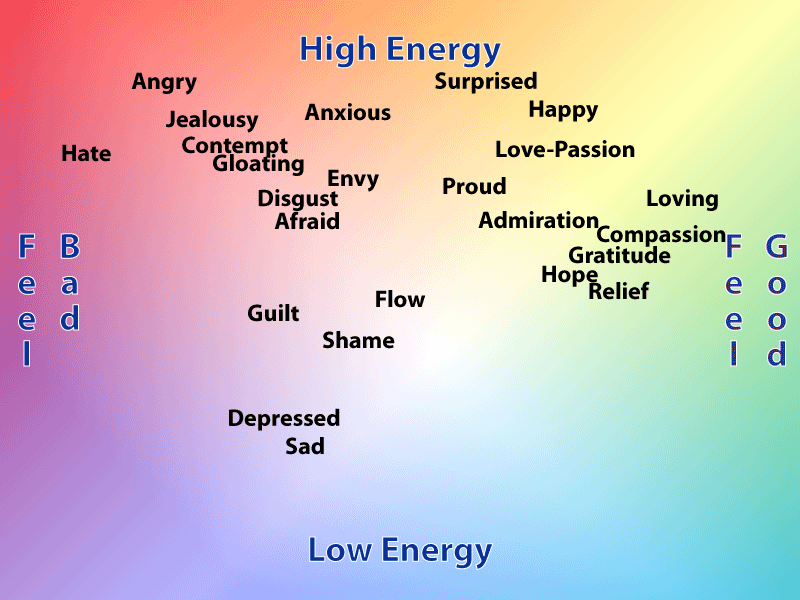Mapping Moods
—How do you feel?
Introduction
[edit | edit source]Many people have difficulty identifying the various emotions they may be experiencing. As a supplement to the course on recognizing emotions, two “mood maps” are provided here.
Objectives
[edit | edit source]The objective of this course is to assist students in identifying the emotions they may be experiencing at any time.
This course is part of the Emotional Competency curriculum. This material has been adapted from the EmotionalCompetency.com page mood map, with permission of the author.
Energy-Affect Map
[edit | edit source]Emotions create subjective feelings that are often evaluated as “feeling good” or “feeling bad”. Emotions also tend to increase or decrease our arousal level, which we often describe as increasing or lowering our energy level.
The map shown here places each of the major emotions roughly where they are often experienced in these two dimensions.
The placement of each emotion on this map is only approximate and very subjective. Each emotion can vary greatly in intensity. For example anger can range from mild irritation to intense rage. Clearly the energy level of those extremes vary greatly. You can improve your ability to recognize emotions in yourself by paying attention to how you are feeling on the good-bad axis and on the energy level axis as you go about your day. Click on each emotion name to learn more about that emotion.
Volition-Depth Map
[edit | edit source]Two other, more subtle dimensions also differentiate among emotions. The first dimension describes the “depth of experience” or “depth of emotional involvement” characteristic of the emotion. The second dimension describes the extent to which the emotion is either involuntary or deliberate. The major emotions are placed on a grid along these two dimensions below.
These charts are based on data obtained from Averill, J.R. (1975) “A semantic atlas of emotional concepts”, JSAS Catalog of Selected Documents in Psychology, University of Massachusetts, Amherst, USA, Vol. 5, No. 330, pp.1-64 (Ms No. 1103).
The “activation” dimension is labeled High/Low energy and the “evaluation” dimension is labeled “Feel good/Feel bad” on the upper chart. The “depth of experience” dimension is labeled Deep/Shallow and the “Uncontrol” dimension is labeled Involuntary/Deliberate on the lower chart.
To better understand each of the four factors used, the fifteen emotional concepts from the list of 558 terms with the highest and lowest scores on each of the four factors are listed in the following table. In each column the terms with the highest score (toward +3) for each factor are listed in the first group. Those with the lowest score (toward -3) are listed in the second group, below the break in the table. The “uncontrol” factor describes the extent of autonomous or involuntary response as opposed to deliberate intent associated with each concept.
| Activation | Evaluation | Depth of Experience | Uncontrol |
| Rampageous
Rambunctious Riotous Rollicking Uproarious Furious Fierce Frolicsome Enraged Peppy Ferocious Excited Ranting Vivacious Hilarious |
Peaceful
Tender Pleasant Kindly Contented Tranquil Harmonious Serene Thoughtful Trusting Compassionate Warmhearted Relaxed Loving Affectionate |
Tragic
Excruciating Ominous Foreboding Grave Painful Macabre Agonizing Heart-stricken Loving Magnanimous Spiritual Caring Understanding Intense |
Terrified
Panicked Blushing Petrified Hysterical Trembling Neurotic Nervous Scared Spellbound Infatuated Delirious Berserk Helpless Frightened |
| Low scoring factors: | |||
| Dreary
Lonely Morbid Grave Somber Glum Despondent Weary Solemn Desolate Fatigued Bored Exhausted Sluggish Mournful |
Morbid
Repulsive Plagued Evil Shattered Hateful Hellish Persecuted Macabre Cruel Tragic Tortured Bloodthirsty Violent Suicidal |
Shaky
Insecure Listless Mischievous Cowardly Fretful Coy Scoffing Frivolous Flirtatious Sheepish Timid Peevish Meek Giddy |
Devilish
Scoffing Confident Greedy Sneering Vindictive Callous Obstinate Composed Heartless Fiendish Serious Determined Cruel Diabolical |


